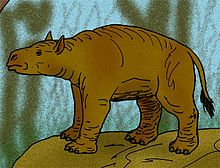Xenungulata
| Xenungulata Temporal range: Paleocene to Eocene |
|
|---|---|
 |
|
| Carodnia vieirai | |
| Scientific classification | |
| Kingdom: | Animalia |
| Phylum: | Chordata |
| Class: | Mammalia |
| Subclass: | Theria |
| Infraclass: | Eutheria |
| Superorder: | †Meridiungulata |
| Order: |
†Xenungulata Paula Couto 1952 |
| Family and genera | |
Xenungulata ("strange ungulates") is an order of extinct and primitive South American hoofed mammals known from deposits in Brazil, Argentina, and Colombia. The best known member of this enigmatic order is the genus Carodnia, a tapir-like and -sized animal with a gait similar to living African elephants.
Xenungulates are characterized by bilophodont M1–2 and M1–2, similar to pyrotheres, and complex lophate third molars, similar to uintatheres. Though other relationships, to for example, have been suggested, no proofs thereof have been found. The foot bones of xenungulates were short and robust and their digits terminated in broad, flat, and unfissured hoof-like unguals, quite unlike any other meridiungulates. The discovery of Etayoa in Colombia made it clear that xenungulate are distinct from other groups: Etayoa lacks lophate molar talonid (in contrast to Carodnia) and, since no distinct lophondonty is present in basal pyrotheres, there is reason to assume that bilophodonty evolved separately in xenungulates and pyrotheres. Xenungulates also show some dental similarity to primitive astrapotheres.
Cifelli 1983 grouped Carodnia with pyrotheres based on a similarity in astragalus morphology, but later concluded that this observation was incorrect.
Notoetayoa is most closely related to Etayoa.
...
Wikipedia
